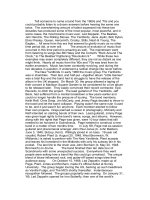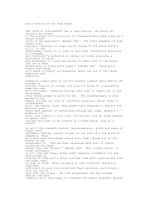45272 history of easter
Bạn đang xem bản rút gọn của tài liệu. Xem và tải ngay bản đầy đủ của tài liệu tại đây (467.45 KB, 2 trang )
th spring two days winter cross rolling candle Good
April 25 th
Friday lamb apostles bunny basket chocolates
Easter, the holiest day of the Christian
calendar, a celebration of Jesus-Christ’s
resurrection from the dead. So what does
this miracle have to do with a ________
delivering painted eggs? The answer lies in a
hundred generations of rituals and customs.
According to the gospels of the New
Testament,
Jesus-Christ
and
his
__________ entered Jerusalem to observe
Passover, the Jewish holy season that
celebrates the Hebrews’ release from slavery.
After the Passover supper, Jesus was
arrested and on what it’s now called
___________________________, he was
crucified. Two days later, he rose from the
dead. Those of Jewish origin were the first to
celebrate the resurrection, likely as a new
fasting of the Passover festival.
In fact, the Easter celebration was called
pascha. It’s derived from the word Pesach,
the
Jewish
translation
for
passover.
Originally,
Easter
was
celebrated
_____________ after Passover, so it fell on
any day of the week but Easter Wednesday
just didn’t feel right.
In 325 AD, Roman emperor Constantine and
the Council of Nicaea rule that Easter must
fall only on a Sunday, the day when Christ
rose. Easter Sunday would be the first
Sunday to follow the full moon after the
spring equinox. It could occur anywhere
between March 22nd and ______________.
Around the same time, Christians began one
of the first recorded rituals of the modern
Easter celebration, the lighting of the paschal
_________, its flame a reminder of Christ’s
resurrection, light out of darkness.
Also during the service, worshipers placed a
lamb under the altar to be blessed. Lamb had
played the sacrificial role in Passover, so early
Christians
portrayed
Christ
as
the
_____________ of God.
As Christianity spread throughout Europe,
different pagan customs blended into the
holidays. In fact, the actual word Easter may
have come from Eastre, the goddess of
_________ and fertility, which brings us to
the Easter egg.
Eggs have been a mythological symbol of birth
for thousands of years. Christians adopted
the egg as an Easter custom sometime around
the 13th century. The yolk inside a shell
represented Christ’s emergence from the
tomb. Eggs were painted red to represent the
blood Christ shed on the________________.
The colorful Easter egg soon hatched its own
traditions.
A
popular
one
was
egg
_______________. In 1876, Congress
prohibited kids from playing on the Capitol
grounds, so President Rutherford B. Hayes
opened the White House lawn to the little
rollers. After that, the White House Easter
egg roll became a tradition.
So when did that Easter bunny happen to the
scene? The fertile rabbit had long been a
symbol of new life in European pagan
celebrations. Beginning around the 16th
century, parents told children that if they
behaved on the eve of Easter, the Oschter
Haws would come and lay colourful eggs.
Children built nests in their homes to entice
the rabbit to visit and so begin the customs
of the Easter egg hunt and the Easter
___________.
To help fill out those baskets, 19th century
European chocolatiers began making eggshaped _____________. The sweet trend
quickly spread throughout the world. Today,
billions of dollars are spent each year on
Easter candy.
Easter is a joyful day when Christians
celebrate the resurrection. For 2000 years
customs have been added, some spiritual and
some fun. But Easter is also the time for
families to gather and welcome spring, when
new
life
emerges
after
the
death
of___________________.
/>
ANSWER KEY
bunny – apostles - Good Friday - two days - April 25 th – candle –
lamb – spring – cross - rolling – basket – chocolates - winter









